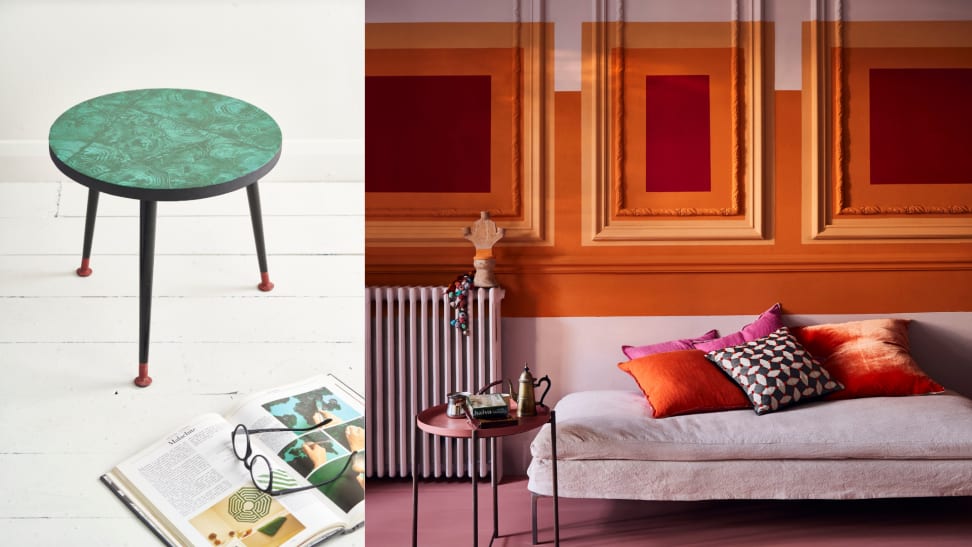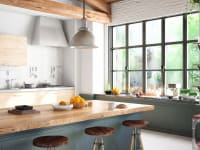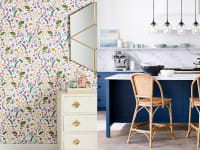Beyond shabby chic, chalk paint can work for any home décor style
It's all about this base
 Credit:
Jesse Wild for Annie Sloan / Annie Sloan
Credit:
Jesse Wild for Annie Sloan / Annie Sloan
Products are chosen independently by our editors. Purchases made through our links may earn us a commission.
If you spend any time on Pinterest or have an appreciation for the modern farmhouse aesthetic, then you’ve likely come across the term “chalk paint." Vastly different from chalkboard paint, and not to be confused with sidewalk paint made from chalk, chalk paint is a flexible, durable, and easy-to-master treatment for furniture, cabinets, walls, floors, and even fabric.
Beloved for its trademark soft, matte look and chalk-like feel, it’s an ideal finish for those who want to add a bit of vintage charm to their home.
If you’re ready to dive in and give your space some DIY love with a fresh coat of paint, here is everything you need to know.
What is chalk paint?

Annie Sloan started a chalk paint movement in the 1990s. Today, her contemporary looks go way beyond shabby chic, as in this chest painted with Chalk Paint by Annie Sloan in Amsterdam Green, and this paneled study wall painted using Paris Grey and Scandinavian Pink, with Arles for molding detailing.
Don't confuse chalk paint for chalkboard paint, a special black paint that you can apply and then write on with chalk after it dries.
Chalk paint gets its name from the chalky appearance and texture it gives to surfaces. Water-based, non-toxic, and free of VOCs, it’s a great option for both novice and seasoned DIY-ers, and people who are doing projects in enclosed spaces with limited ventilation.
Once chalk paint dries, you can use a variety of waxes and lacquers to impart a range of finishes, from a more vintage-style look to one that is highly modern.
While there are many brands that make their own versions of chalk-style paint, Annie Sloan, the British painter and designer, first developed chalk-style paint in the early 1990s and holds the trademark for it with her own, eponymous brand. Designers and those who refurbish furniture have been touting this treatment for 30 years thanks to its ease of use and because it is known for having a reliable, consistent coverage that lends itself well to DIY projects.
How does chalk paint differ from other paints?
Chalk paint's matte finish has made it instantly recognizable, but that is not the only way chalk paint differs from traditional paint.
It requires minimal prep, and it doesn’t require stripping or sanding in the way other paints do. It can also work on a variety of surfaces, including glass, linoleum, builder-grade tile, wood, and particle board—so, yes, it’s perfect for reviving and giving a little bit of personality to your IKEA furniture finds.
Azie Shelhorse, CEO and Creative Director for Verdigreen hotels and residences says chalk paint is her go-to for a variety of renovation and refurbishing projects.
“It’s so versatile,” she says. “It gives these rich and saturated colors. It can really be used for anything, and it sticks to it whatever material you are working with.”
Described as almost “pudding-like,” chalk paint tends to be thicker than traditional paints. This prevents it from dripping as readily, and it also means that it generally requires fewer coats to get a desired smooth coverage, even over multiple layers of paint.
Chalk paint is also water-based, so not only can you easily dilute it to customize its consistency to best suit whatever project you are working on, it’s a snap to clean up, requiring only soap, water, and a rag rather than harsh chemicals and paint thinners.
Shelhorse says that one of the positive byproducts of working with chalk paint is that it's generally safe to use. “It's a safe product to use on furniture that little teeth might end up teething on, and it's also safe to use on kid projects."
Shelhorse has used it for a school-based outdoor mural, and she has even diluted it for family tie-dye projects.
She says, “Fabric dye can stain hands for days, and traditional paint can be hard to wash off. Chalk paint is non-toxic and washes off little hands easily. I’m a little obsessed with it.”
When should you use chalk paint?
While chalk-style paint made its debut in the nascent days of the shabby chic movement, Shelhorse says you shouldn’t confine its usefulness to one specific style trend.
“It’s an outdated myth that chalk paint is only for shabby chic. I've used it for everything from Mid-century modern to boho," she says, adding that it can look very modern and lux due to its matte finish. The bold hues and deep color saturation that this type of paint imparts lends itself to current style trends.
Chalk paint made its name reviving furniture pieces, but it has also made bold statements with color-blocking—particularly with kitchen cabinets. Shelhorse says the matte look of it can can be striking on an entire wall.
When using chalk paint, the best advice Shelhorse gives is to put all preconceived notions aside, and to keep in mind that chalk paint bonds to any clean surface without priming and cures quickly to create a durable surface. She's used chalk paint on linoleum flooring in high-traffic restaurants, on front doors that withstand everything from snowstorms to baking heat, on furniture in nurseries, and even on concrete walls and patios.
“Chalky matte is not the only finish you are limited to. You can use a finish that has gloss to it, and suddenly it’s a durable [lacquered] floor,” says Shelhorse.
What to know
Prepping. Chalk paint is undeniably popular with those wanting to refurbish flea market finds. But, with those finds comes a lot of dust and debris. It's true that chalk paint doesn’t require priming, but it does require a very clean surface to start with, so while priming isn’t part of the process, prepping is.
Curing. The key to chalk paint's durability is to pay close attention to curing it. If you paint a concrete patio or a stucco wall, you will need to allow the paint to dry and then cure over a few days.
Finishing. Depending on your project, you may potentially apply a wax or lacquer finish or topcoat. If you’re painting a furniture piece and you want to keep the matte finish, it’s recommended you seal it with a wax for durability. If you prefer to have a more glossy finish, go for a lacquer that’s specifically made for chalk paint. Pro tip: It’s important to know that a wax or lacquer finish will deepen the color of the paint.
Picking a brush. Because of the thickness of higher quality chalk paints, it’s recommended that you purchase a brush made specifically for chalk paint, as they tend to be denser, softer, and the shed less than other paint brushes.
Which chalk-style paint should you try?

Chalk-style paint from Magnolia Home by Joanna Gaines is a hot seller at Target, since DIYers use it to refurbish unique furniture pieces, like this table, and add modern hardware.
For official, trademarked chalk paint and finishes—as well as chalk paint-specific brushes, you need to find a certified distributor of Annie Sloan paint. There are, however, numerous copycats on the market. We found some imitations that are putting their own spin on chalk paint.
The original creator of chalk paint, Annie Sloan chalk paint is your go-to source for paints, waxes, tools, and brushes. According to bloggers, this one is quick drying and best for furniture products. It also has a devout following, so you may want to enter “Annie Sloan” in your keyword searches to get the best DIY ideas.
HGTV’s “Fixer Upper,” made modern farmhouse chic trendy, so it’s no surprise that Joanna Gaines has come out with her own line of chalk-style paint for her Magnolia Home collection.
Available at The Home Depot, Behr brand has created a tintable chalk paint base that allows you to choose from over 500 different color options.
Rust-Oleum chalk paint comes in a convenient spray bottle. The chalk spray paint claims to dry in 25 minutes with up to 25 square feet of coverage, effectively making the world’s easiest-to-use paint product even easier to use. Rust-Oleum also sells chalk paint in standard paint cans.
The product experts at Reviewed have all your shopping needs covered. Follow Reviewed on Facebook, Twitter, and Instagram for the latest deals, product reviews, and more.
Prices were accurate at the time this article was published but may change over time.


